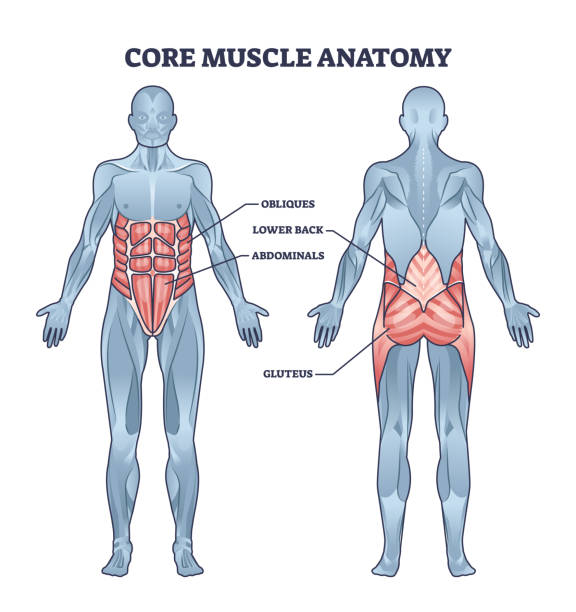While many aspire for a defined six-pack, prioritizing the abdominal muscles alone overlooks the broader significance of core strength in facilitating functional movement and sustaining long-term stability. Beyond the superficial abs lies a complex network known as the core or the “lumbo-pelvic hip complex” or LPHC. This intricate system encompasses stabilizing musculature encircling the trunk, forming a foundational cylinder crucial for stabilizing the spine throughout various movements.

The Lumbopelvic Hip Complex includes:
- Abdominal muscles in the front and sides- rectus abdominis, internal and external oblique, and the transverse abdominis
- Spine and Glute Muscles- Erector Spine, quadratus lumborum, and multifidus
- The diaphragm is the “roof”
- Pelvic floor and hip girdle musculature as the “floor”
These muscles should all work together to stabilize the trunk while our arms and legs move around it during all functional movements. A stable core is the key to preventing injuries to the spine and extremities. When we view the core this way, we must see that if we have a stable core, we will be able to have a mobile body. An unstable core lacking mobility can cause other issues like chronic hamstring tightness, constant upper trap trigger points, low back pain, and fatigue after sitting or standing for longer periods of time.
Assessing Strength And Weakness
Trunk Curl-Up Test
- Lay on your back with knees bent and heels on the floor.
- Place your hands under your spine or on the top of your thighs.
- Curl the upper trunk as if you’re doing a crunch and lift your upper body off the floor to level the shoulder blades.
- The upper trunk should round, the lower back will flatten, and the pelvis tilts posteriorly. If you are unable to complete these movements then your core is weak.
- Additionally, if you notice that when your back arches and the thoracic spine curve is minimal, then the hip flexors (iliopsoas) are most likely overactive, performing trunk flexion movements instead of the core.
Lower Abdominal Coordination Test
- Lie on your back and place your hands under your spine.
- Flex the hips to 90 degrees, knees bent so the feet are flat on the floor.
- Roll your pelvis posteriorly, (tucking your butt) so that your spine is pressing on your fingers.
- Keeping this position, try to slowly lower/slide one heel out until the leg is fully straight, then return to the starting position.
- You should be able to slowly slide the heel fully our and back in without your spine ever leaving contact with your fingers.
Glute Bridge With Knee Extension
- Lie on your back and place your hands under your spine.
- Flex the hips to 90 degrees, knees bent so that your feet are flat on the floor.
- Roll your pelvis posteriorly, (tucking your butt) so that your spine is pressing on your fingers.
- While in the “spine-locked and pelvis tucked” position, push through your heels to raise your hips towards the ceiling to perform a glute bridge.
- While in this position, lift one leg by straightening the knee.
- When straightening the knee, the pelvis and trunk should not rotate, drop on one side, or shake. Your low back and hamstrings should not cramp, or lose full extension. If it does, your glutes are inhibited and don’t have adequate strength to maintain a stable pelvis during functional movement, especially single-leg stance movements.
What To Do About A Weak Core
If you’ve encountered challenges or discomfort during the assessments outlined above — whether it’s pain, instability, or weakness — it’s wise to consider scheduling an appointment with a provider that specializes in functional movement. While core strength training is often beneficial, seeking guidance from a qualified healthcare professional is key to pinpointing specific weaknesses and determining the most effective exercises to address them, thereby reducing the risk of overuse injuries and other complications. At Dynamic Sports Therapy, after a functional movement assessment, our dedicated team of doctors craft personalized corrective exercise programs tailored to each patient’s unique physiological requirements, ensuring optimal recovery and performance enhancement.
Problems Caused By A Weak Core
- Lower back pain
- Poor balance
- Poor posture
- Difficulty standing for long periods of time
- Difficulty getting up from the sitting position without using hands for support
- Anterior pelvic tilt
- Lack of power and stability in your upper body
- Difficulty walking upright without swaying toward one side
- Less control in other areas like the legs and hips
- Difficulty with everyday tasks that require core strength like lifting a child, carrying boxes, carrying groceries, walking up stairs, etc,
Core stability is arguably the most important factor to injury prevention for not only the spine but also the rest of the body. It allows adequate energy and force transfer when doing all movements like bending, lifting, throwing, squatting, jumping, etc., My best advice as a functional movement focused practitioner (and someone who’s goal is to help athletes of all stature prevent injury to keep them doing what they love) is to focus on the core first before jumping to other conclusions.
This week’s post is authored by Dr. Bailee Mims.